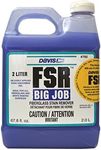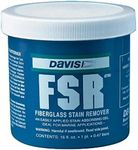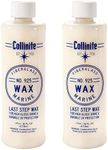Buying Guide for the Best Boat Fiberglass Cleaner
Choosing the right fiberglass cleaner for your boat is important to keep your vessel looking great and to protect its surface from damage. The right cleaner will remove stains, oxidation, and grime without harming the fiberglass or any protective coatings. When shopping for a fiberglass cleaner, it's important to understand the key features and specifications that can affect how well the product works for your specific needs.Cleaning StrengthCleaning strength refers to how powerful the cleaner is at removing dirt, stains, oxidation, and other contaminants from fiberglass surfaces. Some cleaners are formulated for light cleaning and regular maintenance, while others are designed to tackle heavy stains or deep oxidation. If your boat is only lightly soiled or you clean it often, a mild cleaner is usually sufficient and gentler on the surface. For boats with heavy staining, chalkiness, or oxidation, a stronger cleaner may be necessary. Always match the cleaning strength to the condition of your boat’s fiberglass to avoid unnecessary abrasion or damage.
AbrasivenessAbrasiveness describes whether the cleaner contains scrubbing particles or chemicals that physically remove stains and oxidation. Non-abrasive cleaners are gentle and safe for regular use, making them ideal for well-maintained boats. Abrasive cleaners, on the other hand, are more effective at removing tough stains and oxidation but can wear down the gel coat if used too often. Choose a non-abrasive cleaner for routine cleaning and an abrasive one only when you need to restore neglected or heavily oxidized surfaces.
Application MethodThe application method refers to how the cleaner is used—whether it’s a spray, liquid, gel, or paste. Sprays and liquids are easy to apply and spread over large areas, making them convenient for quick cleanups. Gels and pastes tend to cling better to vertical surfaces and are often more effective for spot cleaning or treating stubborn stains. Consider how you prefer to clean and the areas you need to treat when choosing the application method that fits your routine.
Biodegradability and Environmental SafetyBiodegradability and environmental safety indicate whether the cleaner is safe for the environment, especially important when cleaning boats near water. Biodegradable cleaners break down naturally and are less likely to harm aquatic life. If you often clean your boat in or near water, or if you want to minimize your environmental impact, look for products labeled as biodegradable and environmentally friendly.
Compatibility with Protective CoatingsSome fiberglass cleaners are safe to use on surfaces that have been waxed or treated with protective coatings, while others may strip these layers away. If your boat’s fiberglass has a wax or sealant applied, make sure to choose a cleaner that is compatible and won’t remove these protective layers. This helps maintain the shine and protection of your boat’s surface.
Ease of UseEase of use covers how simple and convenient the cleaner is to apply, work with, and rinse off. Some cleaners require scrubbing or multiple steps, while others are spray-on and wipe-off. If you prefer a quick and easy cleaning process, look for products that advertise simple application and minimal effort. If you don’t mind spending more time for a deeper clean, a more involved product may be suitable.













